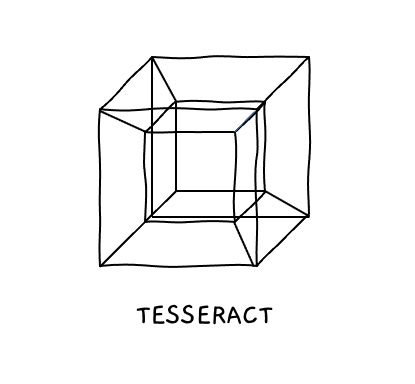A Square Sees a Sphere
Learning one dimension at a time
I have this strange little book on my shelf called Flatland: A Romance of Many Dimensions by Edwin Abbott. It’s not a particularly good book, but I keep it around because I love the premise: A square sees a sphere. The square’s perception of the third dimension is limited to the bounds of his reality in the second dimension. So, the 3D sphere looks like a growing and shrinking circle.
The square, confined to the second dimension, cannot perceive the truth of the sphere.
If we extrapolate the square’s experience, we (as 3D beings) could understand our relationship to the fourth dimension. My perception is elementary, but here’s how I think about geometric dimensions:
The first is length, x
The second is width, y
The third is height, z
The fourth is another vector, w
If you apply another vector (w) to a 3D cube, you get a tesseract.
If tesseract sounds like something from science-fiction, it’s because it is—Charles Hinton, a British mathematician and sci-fi author, coined it. Practically speaking, let’s consider this fourth dimension as time.
Imagine a bunch of Earths lined up for a given moment. We could travel from Paris to Tokyo on a single globe by plane, but we’d have no way to manipulate time—we can only move forward—so we’d arrive in Tokyo 12 hours later. If you were a fourth-dimensional being, you could navigate not only the 3D space of one globe but also traverse time across globes. A 4D being could move from 1890 Paris to 2009 Tokyo to 35 BC Rome as quickly as we walk from the kitchen to the bathroom to the bedroom.
4D travel is mind-boggling because we’re not citizens of that dimension. It’s a level above us.
N+1 Dimensions
Just like the square could barely perceive 3D, humans can barely understand 4D, for we can only perceive N+1 dimensions from where we sit. If we were limited to N dimensions, we’d have no room for growth. But our brains offer a teaser of the next dimension—N+1—to entice our curiosity.
What if we considered domains beyond geometry? Are we still like the square perceiving a sphere?
When learning something new, the first dimension is the most fundamental building block of the domain. When learning to read, the first dimension is the alphabet, as we must understand the letters before reading anything. As children at this stage, we know the next dimension (words) exists, but words look like gibberish until we are comfortable with A to Z.
When we become citizens of this next dimension—able to read “cat” and “dog” and “run” and “jump”—we begin to perceive sentences. As we cross from the 2D realm of words to the 3D realm of sentences, we understand grammar, subjects & objects, and the concept of questions. Once comfortable with sentences, we start understanding the meaning. We pick up things like tone and motive as we think beyond the literal to the symbolic.
Stable Foundations
Each dimension becomes exponentially more complex than the last. In English, we go from 26 letters to 300,000+ words to infinite sentences to even more infinite meanings. Without a stable foundation in the Nth dimension, we can’t inhabit the N+1 dimension.
In college, I struggled in computer science courses because I didn’t work hard enough to establish a strong foundation. I understood conditional logic, loops, and recursion, but I didn’t spend sufficient time solidifying my knowledge of data structures. So, when more advanced concepts like graph theory emerged, I could hardly pass the exams, and it took me years later to cement these knowledge gaps.
A square can’t understand a tesseract if he can’t understand a cube.
A Multidimensional Learning Path
When starting something new, what if we created a multidimensional map of our journey from line to tesseract? To do so, we’d need to discover the first principles of a domain.
As a native English speaker, it’s relatively easy for me to grasp the first principles of Spanish. The alphabet is similar—mostly the same Roman characters—so I can quickly move from letters to words. Learning Japanese, however, is much more difficult because I must spend time understanding kanji characters to set a stable base.
Given the limits of our knowledge, it’s rarely straightforward what higher dimensions exist, as we can only barely perceive the one ahead of us. Maybe there’s a Taoist undertone here, but isn’t this the essence of a journey? Forays into the opaque are natural for us—past humans have traversed unknown seas to map unknown continents. We must move forward, one dimension at a time, to find the next.
It’s not an easy path, especially as we enter higher dimensions, but maybe it’s the only way to true understanding. With curiosity and persistence, our humble square could become a cube and see the sphere for who she is.
Junk Drawer
A good framework for how to make better presentations.
This map of notable people throughout history.










Loved this! I remember reading about a tesseract about 45+ years ago in a book called ‘A Wrinkle In Time’ . Very good science fiction book!
I totally enjoyed this once again! Thank you for sharing.🤗